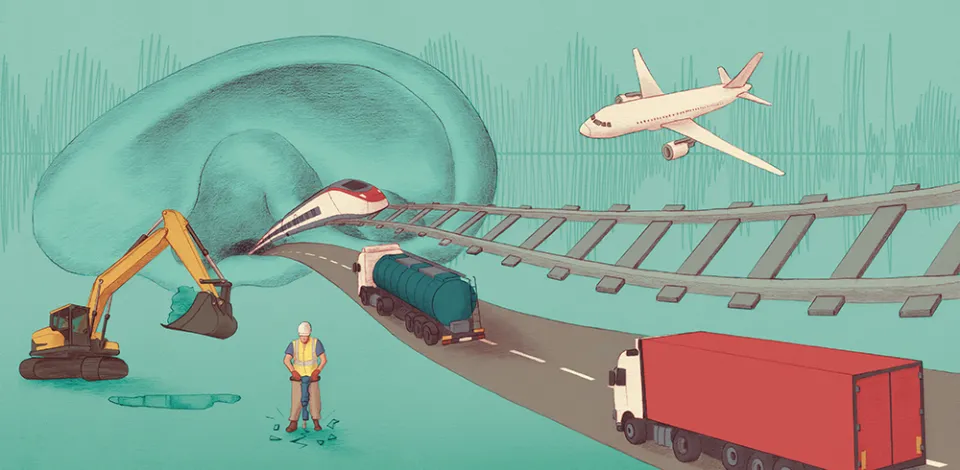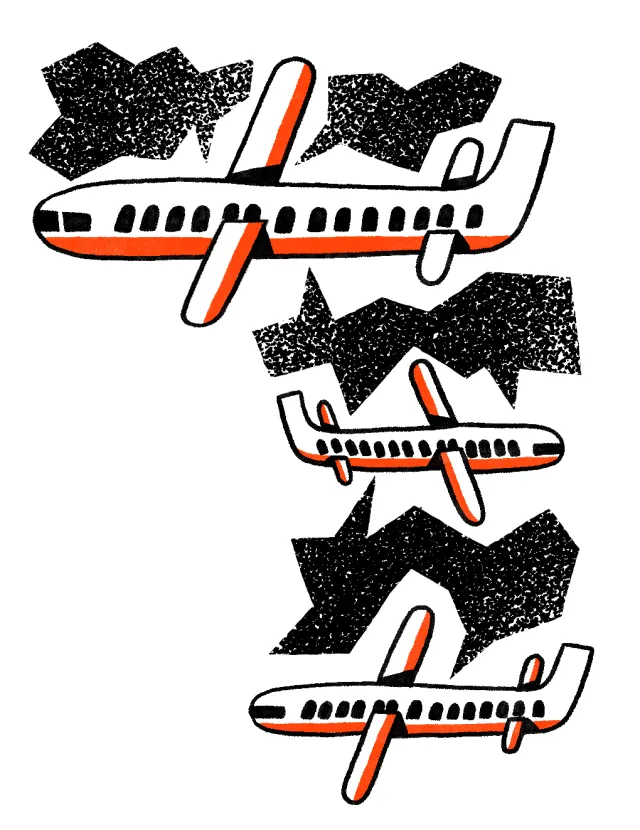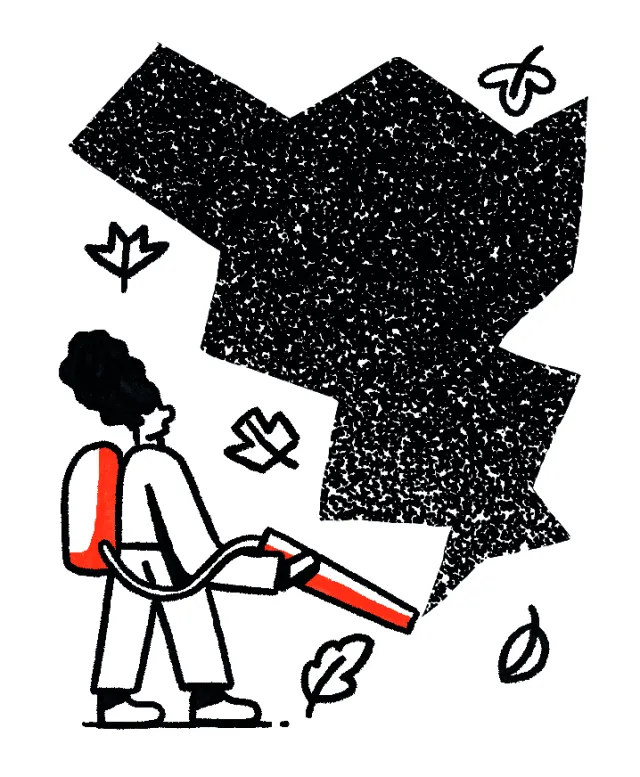SHHHHHHHHHHHHHH!
Smith Quarterly
Quiet Communities is helping people fight back against unwanted noise
Illustrations by Beth Walrond
Published April 21, 2025
It was 3 a.m. when Jamie Harris Banks ’76 got the desperate call from a man in a small Louisiana town. For three years, he and his wife had been enduring the roaring, grinding, window-rattling noise from a daily parade of trucks passing by their home en route to a landfill and gravel pit. With the din starting in the wee hours of the morning and continuing all day, life had become hell for the couple and their neighbors on their rural stretch of road.
“There’s people down here suffering right now,” he said. They needed someone to help them.
While such calls don’t usually come in the middle of the night, they have become a regular thing for Banks.
As founder and president of Quiet Communities—a nonprofit based in Lincoln, Massachusetts—she has made it her mission to educate the public about the serious health impacts of noise pollution and to help communities challenged by noise find solutions.
“Noise is the new secondhand smoke,” Banks says. “Like cigarette smoke, it’s an involuntary exposure to something harmful.”
While most people know that being exposed to very loud noise can lead to hearing loss, noise can cause harm even at much lower decibel levels when it becomes a constant presence. Chronic noise increases stress, Banks says, which can impact cardiovascular, metabolic, and psychological health and even affect cognition and the immune system—all of which is well-documented in a growing body of medical research. Increased risk of heart attack, stroke, high blood pressure, diabetes, obesity, and more have all been linked to the effects of living with chronic noise.
The World Health Organization estimated in 2011 that at least 1 million healthy years of life are lost each year in Western Europe from exposure to environmental noise. In the United States, a 2015 study found that lowering environmental noise exposure by five decibels could reduce hypertension and coronary heart disease cases, and estimated that the associated cost savings and productivity gains could exceed $3.9 billion annually. Among that study’s co-authors are two Quiet Communities advisers: Rick Neitzel, a professor at the University of Michigan School of Public Health, and Monica Hammer, an environmental public health lawyer.
“It’s serious,” Banks says. “There are communities today that are severely impacted. They may have hundreds of flights a day going at a low altitude over their homes. They may have constant construction noise or industrial noise coming from things like data farms and waste facilities. Then there is car and truck traffic, railway noise, and noise from modified vehicles. All of these sources on a chronic basis can really stress people out and keep them awake at night, so their sleep is fragmented. This affects our health.”
Illustration by Elizabeth Sanduvete
It was lawn care noise—the bane of many suburbanites’ existence—that turned Banks into an advocate. A longtime health care and environmental scientist and consultant, she was living in the Boston suburb of Lincoln and working from home when she found herself increasingly disturbed by the daily din of leaf blowers, string trimmers, and industrial lawnmowers. “There was just hours of noise several days a week, coming right through walls and windows. It was very unpleasant.” Banks started bringing her concerns to town meetings and joined a citizens group that eventually became an official town committee. And, like the scientist she is, she did her research. “I started looking into the health impacts of both the noise and the exhaust emissions that went along with all of this gas equipment.”
Her research led her to Peter and Susan Kendall, a California couple who had been profiled in The New Yorker for their own work on the issue. She began meeting with them and shared an idea she had to create evidence-based resources that could help others working to change noisy, polluting landscaping practices in their communities.
The couple wrote her a check for $1,000 on the spot, and that was the start of Quiet Communities, which incorporated as a nonprofit in 2013.
Since then, Quiet Communities has developed a substantial land care program focused on shifting landscape maintenance to low-noise, zero-emissions equipment. The organization collaborates in that work with the American Green Zone Alliance, which educates and supports the landscape industry in adopting healthier practices.
But Quiet Communities does much more. As Banks began hearing from people across the country troubled by many different sources of noise, her mission expanded. The organization now has a Quiet Streets program, a Quiet American Skies program aimed at aviation noise, a Quiet Restaurants program that works to raise awareness in the industry about the challenges noisy eateries pose for those with hearing limitations, and a Quiet Healthcare initiative, which advocates for quieter environments in hospitals and other health facilities—something research has shown can minimize medical errors and improve sleep quality, recovery, and health outcomes for patients.
Quiet Communities’ work takes many forms, including organizing conferences, presenting to municipalities and professional groups in medicine and law, and creating informational resources. For example, the organization recently prepared a presentation for the National Coalition Against Cryptomining, which advocates for communities in more than a dozen states that are besieged by the constant noise emitted by vast data farms related to cryptocurrency. Banks, who is frequently quoted in the media, also travels regularly to offer advice to communities dealing with chronic noise, and she stays on top of the growing scientific research on the topic. She was recently the guest editor of a special “noise issue” of the Journal of Exposure Science & Environmental Epidemiology, published in January, that included a research paper she co-authored on the community impacts of aviation noise.
Quiet Communities also provides support to local organizations like Quiet Florida, an independent group that works in the city of Naples to combat noise pollution from the local airport and from the deafening sounds of modified mufflers and exhaust systems on cars and motorcycles.
“Having the board and Jamie’s backing, expertise, and advice definitely assisted Quiet Florida in growing,” says founder Mary Tatigian, a nurse and chair of the Quiet Streets program of Quiet Communities. “Their platform is huge, they have an impeccable reputation, and they reach people all across the U.S. with their message.”
Quiet Communities does all of this with an annual budget of $375,000 funded by grants, donations, membership dues, and consulting fees; a small staff mostly working on a part-time contract basis; a cadre of devoted volunteers; and the expertise of its 22-member scientific advisory council and 10-member legal advisory council. “We’re definitely punching above our weight,” says Banks, who was able to begin paying a part-time executive director in 2024 to help with the workload, which can consume 50 hours of her week or more. “This is my retirement life,” she says with a laugh.
Massachusetts State Representative and Quiet Communities supporter Alice Hanlon Peisch ’76 describes Banks as “smart, with a great sense of humor and a strong work ethic.”
“She has always marched to her own drummer—something not unusual among my Smith classmates. She is also very pragmatic and solutions-oriented, which makes Quiet Communities much more effective.”
Karen Maloney ’75 is another staunch supporter of Quiet Communities. A mutual friend introduced Maloney to Banks (they didn’t know each other at Smith) thinking Banks might benefit from Maloney’s help as a pro bono fundraising consultant. Maloney says she’s been deeply impressed by Banks and Quiet Communities Executive Director Tricia Glass. “I have seen all kinds of startups that are going to change the world, and they never get past year one because they can’t get themselves financially stable and sustainably funded,” she says. “But Quiet Communities has done that.”
Creating an organization as big and multilayered as Quiet Communities is something Banks was well suited to do. Uniformly described as a warm and gracious leader, she also brings a deep background in science to the job, including a master’s degree in interdisciplinary sciences from the Massachusetts Institute of Technology and another in clinical evaluative sciences from the Geisel School of Medicine at Dartmouth.
Banks also earned a doctorate in social policy and health economics from the University of Kent in England. When she entered that program in the early 2000s, she was a divorced single mother of three boys, ages 12 to 16, and was working full time as a consultant. Banks, who now has five grandchildren, says of that period, “It was very stressful, but it was also wonderful. When you go back to school when you’re older, you really appreciate what a luxury it is to have a great education.”
She also credits some of her success to the strong liberal arts foundation she received at Smith, where she was a biochemistry and government double major. “Having that broad education was very, very useful,” she says.
Banks’s science bona fides have helped her recruit many of the country’s top researchers on noise and public health for Quiet Communities’ Scientific Advisory Council. Members of the council, in fact, were instrumental in pushing for a revised public health definition of noise, changing it from “unwanted sound” to the more precise “unwanted and/or harmful sound.” The Acoustical Society of America adopted the new definition in 2019, and since then the American Public Health Association and the International Commission on the Biological Effects of Noise have followed suit.
Sounds at or Above 70 dB Are Not Safe
80 dB
City traffic
90 dB
Blow dryer
100 dB
Motorcycle
135 dB
Jet engine from 100 yards
Quiet Communities scientific adviser Arline Bronzaft, a professor emerita at the City University of New York, has been engaged in the issue of noise since the 1970s. She did early landmark research on how transit noise near schools affects classroom learning and on the impact of airport-related noise on nearby residents, and has written widely on the subject of noise, including as a co-author of the 2011 book Why Noise Matters: A Worldwide Perspective on the Problems, Policies, and Solutions.
Bronzaft praises Banks for launching and building Quiet Communities. “Jamie surrounded herself with good people who want to do something about noise,” Bronzaft says. “That was really her test as a leader, to get other people to join her in this effort. Since she formed that organization, particularly in the last two or three years, it has drawn so much more attention to the adverse effects of noise.” (Bronzaft observes that noise pollution is also harmful to animal life, impacting everything from the migratory patterns of birds to the echolocation of whales.)
Neitzel, the professor from the University of Michigan School of Public Health, is also on the Quiet Communities scientific advisory council. He studies the health impacts of both occupational and environmental noise and cautions that even though we may think we have become habituated to chronic noise in our environment, our body still perceives it, and important bodily processes, such as sleep, will be affected. “We know that sleep disruption is a very strong predictor of cardiovascular disease,” Neitzel says. “So living next to that freeway, even if you think you’ve grown used to it, your nervous system never grows used to it.”
Another Quiet Communities science adviser, Mathias Basner, a psychiatry professor at the University of Pennsylvania Perelman School of Medicine, studies the effects of transportation and aviation noise on sleep. “Noises cause stress, especially if we have little or no control over them,” Basner says. “The body will excrete stress hormones like adrenaline and cortisol that lead to changes in the composition of our blood and of our blood vessels, which actually have been shown to be stiffer after a single night of noise exposure.”
Sounds at or Below 70 dB Are Safe
20 dB
Ticking watch
30 dB
Rustling leaves
60 dB
Background music
70 dB
Average office noise
The lack of control over noise is key, says Banks, who observes that chronic noise exposure has become an environmental justice issue. With few affordable housing options in most locales, lower-income residents are more likely to end up living next to highways, airports, train lines, or industrial areas. And it is poor neighborhoods that are typically targeted when it comes to siting trash facilities or other noisy operations.
The fact that lower-wealth communities are disproportionately affected by chronic noise is no surprise to Smith psychology professor Benita Jackson, campus adviser for the interdisciplinary Five College program in Culture, Health, and Science. Jackson specializes in social epidemiology and studies the psychology of how society affects mental and physical health. In the many health problems caused by noise, she sees a connection to what’s called self-determination theory, which posits that after basic physical needs are met, humans have three key psychological needs in order to thrive: autonomy, competence, and relatedness. But unwanted noise over which we have no control sharply challenges the first item on the list, Jackson says. “The jackhammers, the traffic, and the planes going overhead undermine people’s sense of autonomy, and that can have really profound health implications psychologically and physically too.”
This has been the case for St. Helena Parish, the rural Louisiana community where constant truck traffic interrupts residents’ sleep. Since Banks got that middle-of-the-night call in 2021, she has visited twice to meet with residents and try to help.
The results show what people dealing with chronic noise are up against. With no federal oversight and few or lax local regulations on noise, relief can be hard to come by.
In Louisiana, a letter-writing campaign to local officials and the business responsible for the truck noise got no replies. But Quiet Communities’ efforts to call attention to the low-income community’s plight and to educate the public about noise resulted in a lengthy news article posted on the statewide Louisiana Illuminator site in October. In response to the reporter’s queries, the environmental agency that is charged by state statute to regulate noise claimed that it had no authority to do anything about the situation. The article also quoted a municipal official defending the gravel pit’s operation as a commercial enterprise with “rights and protections.” His suggestion for residents? Buy white noise machines.
Still, Banks has not given up. She’s not discouraged. She sees the big picture, and she’s in it for the long haul.
“The world is becoming noisier and noisier, and there’s no place to go to escape it,” she says. “People are very frustrated.”
Eils Lotozo is a freelance writer who lives in a suburb of Philadelphia where the noise of lawn mowers and leaf blowers is impossible to escape. She was the editor of the Haverford College alumni magazine for more than a decade.
When America Took Noise Seriously
The health effects of noise are something we’ve known about for a long time. In fact, noise was first declared a public health hazard in the U.S. back in 1968. A few years later, the Noise Pollution and Abatement Act of 1972 established a federal Office of Noise Abatement and Control within the newly formed Environmental Protection Agency.
That office was charged with regulating noise levels from such sources as motor vehicles, aircraft, heating and cooling systems, and major appliances. It was also tasked with research, funding, and providing educational resources and technical assistance to state and local governments. All of this was strengthened in 1978 by a follow-up piece of legislation called the Quiet Communities Act.
Then, in 1982, the Reagan administration pulled funding for the office and shut it down, shifting the responsibility for noise regulation to state and local governments. But that hasn’t worked, says Banks, who launched her organization before she learned of the 1978 legislation of the same name. With no federal guidance or enforcement, local and state governments have struggled to develop their own ordinances. According to a policy brief published by the American Public Health Association in 2021, “there is little consistency across states and municipalities with regard to the descriptors, criteria, and methods incorporated in noise legislation.”
Quiet Communities is trying to do something about that. Since the original Noise Pollution and Abatement Act was never repealed, in 2017 Banks and her Quiet Communities legal advisers worked with the University of Washington Regulatory Environmental Law & Policy Clinic to file a petition asking the EPA to reactivate the noise control program. When they got no response, they filed a lawsuit against the EPA, which is currently sitting in the courts.
“At one time, the U.S. really was the global leader on noise,” says Banks. “If you look at what that office [of Noise Abatement] did and what they published, it’s amazing. That defunding really halted progress on noise, and in the meantime we have become a much noisier world.”
By Eils Lotozo




